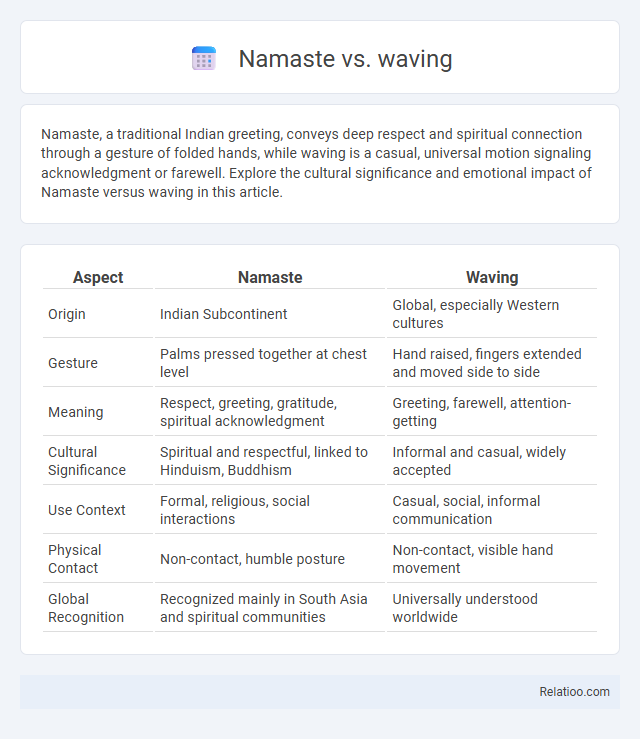Namaste, a traditional Indian greeting, conveys deep respect and spiritual connection through a gesture of folded hands, while waving is a casual, universal motion signaling acknowledgment or farewell. Explore the cultural significance and emotional impact of Namaste versus waving in this article.
Table of Comparison
| Aspect | Namaste | Waving |
|---|---|---|
| Origin | Indian Subcontinent | Global, especially Western cultures |
| Gesture | Palms pressed together at chest level | Hand raised, fingers extended and moved side to side |
| Meaning | Respect, greeting, gratitude, spiritual acknowledgment | Greeting, farewell, attention-getting |
| Cultural Significance | Spiritual and respectful, linked to Hinduism, Buddhism | Informal and casual, widely accepted |
| Use Context | Formal, religious, social interactions | Casual, social, informal communication |
| Physical Contact | Non-contact, humble posture | Non-contact, visible hand movement |
| Global Recognition | Recognized mainly in South Asia and spiritual communities | Universally understood worldwide |
Introduction: The Origins of Namaste and Waving
Namaste originates from ancient Indian traditions, symbolizing respect and spiritual acknowledgment by joining hands at the heart chakra. Waving traces its roots to medieval Europe where it served as a non-verbal gesture to signal peaceful intentions or friendly recognition from a distance. Both rituals reflect cultural values of respect and connection, yet Namaste emphasizes inner reverence while waving focuses on social acknowledgment.
Cultural Significance of Namaste
Namaste holds deep cultural significance in South Asian traditions, symbolizing respect, humility, and the acknowledgment of the divine in another person. Unlike waving, which is a casual, physical gesture common in Western cultures, Namaste conveys a spiritual connection and is often accompanied by a slight bow with pressed palms. Your use of Namaste demonstrates mindfulness of cultural values and fosters a respectful interaction beyond a simple greeting ritual.
Historical Background of Waving
Waving has roots dating back to ancient civilizations, where it served as a non-verbal signal to show friendliness or recognition across distances. Unlike the deeply spiritual gesture of Namaste, which originates from Indian culture and symbolizes respect and unity, waving evolved primarily as a practical communication tool. Your understanding of these gestures can enrich cross-cultural interactions by appreciating their unique historical origins and social contexts.
Symbolism Behind Both Gestures
Namaste, with hands pressed together at the heart chakra, symbolizes respect, humility, and the acknowledgment of the divine within each person, embodying a spiritual connection beyond physical interaction. Waving serves as a universal gesture signaling attention, acknowledgment, or farewell, often representing openness and friendliness without deeper spiritual connotations. Greeting rituals vary globally but commonly combine gestures and expressions that convey respect, social bonding, and cultural values, enhancing interpersonal harmony and mutual recognition.
Namaste vs Waving: Social Contexts
Namaste and waving serve distinct roles in social contexts, with Namaste rooted in Indian culture symbolizing respect and spiritual acknowledgment through a gesture of folded hands. Waving is a more casual, universal greeting often used to attract attention or signal hello and goodbye across cultures. Your choice between Namaste and waving can reflect cultural sensitivity and the nature of your social interaction, honoring tradition or opting for informal communication.
Body Language and Nonverbal Communication
Namaste involves a slight bow with hands pressed together at the chest, conveying respect and humility through nonverbal communication. Waving uses an open hand movement, signaling friendliness or recognition from a distance with clear visual cues in body language. Your choice between these greeting rituals can shape social interactions by expressing cultural values and emotional intent without words.
Health and Hygiene Considerations
Namaste, a traditional Indian greeting, involves pressing the palms together at the chest, minimizing physical contact and reducing the risk of transmitting germs compared to waving or handshakes. Waving is a contact-free gesture that limits direct contact but may not convey the same level of respect or cultural significance as namaste. Your choice of greeting ritual can enhance health and hygiene by avoiding physical touch, especially important during pandemics or flu seasons.
Modern Adaptations and Global Influence
Namaste, waving, and traditional greeting rituals have evolved significantly in modern society, blending cultural respect with global convenience. You can observe Namaste gaining international popularity as a contactless gesture symbolizing respect and mindfulness, especially post-pandemic. Meanwhile, waving remains a universal, informal signal of acknowledgment, reflecting the globalization of simple, inclusive communication methods.
Which Gesture Fits Today’s World?
Namaste, a traditional Indian gesture symbolizing respect and spiritual acknowledgment, offers a contactless and culturally profound greeting aligning with modern hygiene concerns and global mindfulness trends. Waving, a universally recognized and casual gesture, facilitates quick, non-verbal communication suitable for diverse social settings and digital interactions. Choosing today's ideal greeting depends on context: Namaste enhances meaningful connections emphasizing respect, while waving suits informal, fast-paced encounters in a digitally connected world.
Conclusion: Choosing Respectful Greetings
Choosing respectful greetings depends on cultural context and personal preferences, as Namaste conveys deep respect through a traditional gesture, while waving offers a casual, universally understood acknowledgment. Your choice should reflect the setting and relationships involved, ensuring communication is both meaningful and appropriate. Understanding these nuances fosters mutual respect and enriches social interactions globally.

Infographic: Namaste vs Waving
 relatioo.com
relatioo.com